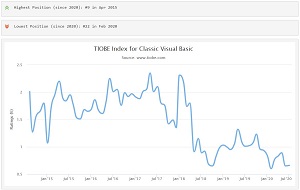News
Popularity Index: Classic Visual Basic Hangs In There
While the latest TIOBE Index of programming language popularity isn't earth-shaking -- focusing on an all-time high for statistical language R -- perhaps the biggest surprise is this: Classic Visual Basic (VB6) is still in the top 20.
That's surprising considering that:
- Visual Basic was first released 29 years ago
- The last stable release of VB6 (succeeded by VB.NET) was 22 years ago
- It was retired by Microsoft, losing support, in 2008
Yet there it is, hanging in there at No. 20 in the July 2020 TIOBE Index.
That puts it above old favorites and new darlings including:
- Objective-C: until several years ago the go-to language for iOS and OS X Apple-centric development
- Dart: the hot language from Google that powers the hot Flutter framework
- Kotlin: the new darling of the Android crowd, succeeding Java
- TypeScript: Microsoft's type-optional take on JavaScript, continually posting new popularity milestones
- Groovy: which is apparently pretty cool, just judging by its name
As noted several times now, VB6 just refuses to go away, achieving cult-like status among a group of hard-core supporters.
For example, though it's gone now, a UserVoice post titled "Bring back Classic Visual Basic, an improved version of VB6" garnered 11,361 votes and 5,480 comments back in 2016.
 [Click on image for larger view.]
A Graphic Accompanying a UserVoice Post Asking To Bring Back VB6 (source: Microsoft UserVoice)
[Click on image for larger view.]
A Graphic Accompanying a UserVoice Post Asking To Bring Back VB6 (source: Microsoft UserVoice)
If you look at the Visual Studio Marketplace, you can still find "Visual Basic Tools for Visual Studio," by Matthias Friedrich, who as of early this year was still updating the extension for older VS versions " allowing us to work on classic Visual Basic projects within Visual Studio."
In 2016, David Platt
proposed "How about we develop a version of VB6 that produces HTML5? The output would then run in any browser, on any OS, on any platform, desktop or mobile."
Then there's @radbasic, whose Twitter site is followed by none other than Microsoft's Scott Hanselman and which states "I am VB! and PROUD of it! RAD Basic: IDE and compiler 100% compatible with Visual Basic 6 (AKA Visual Basic classic)." The project's web site, radbasic.dev, says it's "Launching on Kickstarter soon!"
That's despite a death knell (one of the latest) for the language sounded by Matthew MacDonald in a post about a year ago titled "The Rise and Fall of Visual Basic," asking "After 28 years, are we are finally seeing the beginning of the end for one of the world's most popular languages?"
And Microsoft has refused to budge on multiple entreaties to bring back VB6 or open source its code for the community.
Things don't look much brighter for the broader VB ecosystem. Even though VB.NET hit a new high in the TIOBE Index in 2018, Microsoft early this year declared "We Do Not Plan to Evolve Visual Basic as a Language."
Indeed, the latest TIOBE Index shows that Classic Visual Basic sank from 17th place last year to 20th place this year. Its chart over the years looks like this:
 [Click on image for larger view.] TIOBE Index for Classic Visual Basic (source: tiobe.com).
[Click on image for larger view.] TIOBE Index for Classic Visual Basic (source: tiobe.com).
That's a downward slope, to be sure.
Perhaps MacDonald is right when he writes:
Visual Basic has been threatened before. But this time feels different. It seems like the sun is finally setting on one of the world's most popular programming languages. Even if it's true, Visual Basic won't disappear for decades. Instead, it will become another legacy product, an overlooked tool without a passion or a future. Whether we've lost something special -- or finally put an old dog out of its misery -- is for you to decide.
So, what's your decision?
About the Author
David Ramel is an editor and writer at Converge 360.